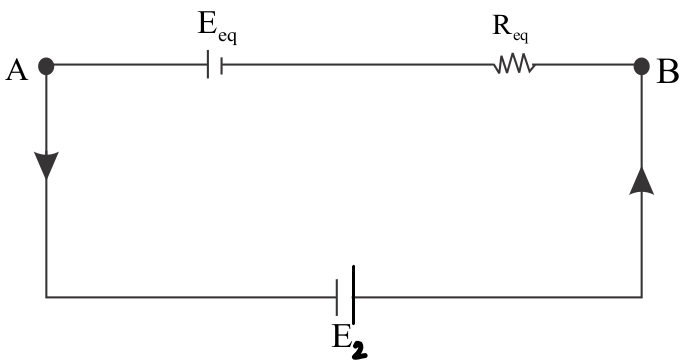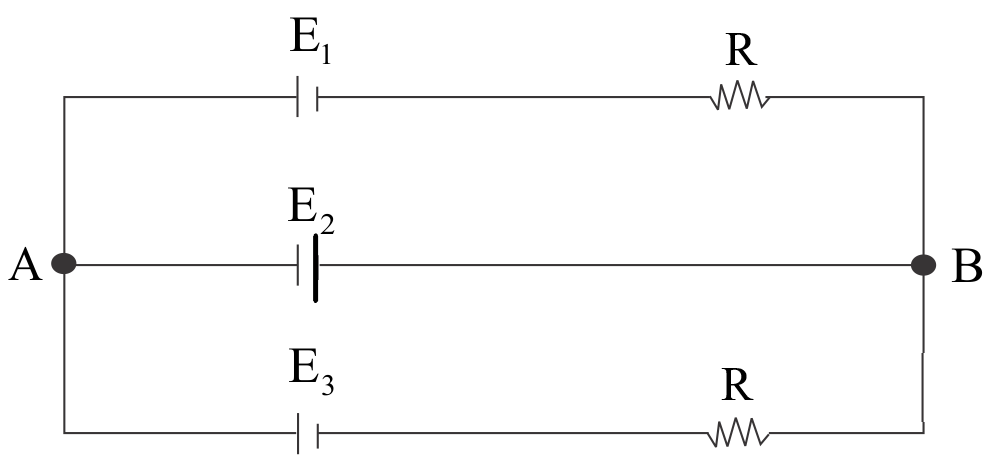Answer
44.4k+ views
Hint: Current flows through the path of least resistance. In the given circuit, find the equivalent emf and resistance. This can then be used to find the current flowing through the circuit.
Complete step by step solution:
We first need to simplify the circuit given to us. Since we need to find out the current through the battery $E_2$, we exclude it while finding out the equivalent emf of the batteries and the equivalent resistance. We only find the equivalent of $E_1$ and $E_3$ and the resistances $R_1$ and $R_2$.
The equivalent emf is given by the equation,
${E_{eq}} = \dfrac{{{E_1}{R_2} + {E_3}{R_1}}}{{{R_1} + {R_2}}} = \dfrac{{2 \times 4 + 2 \times 4}}{{4 + 4}} = \dfrac{{16}}{8} = 2$ V …equation (1)
We now find out the equivalent resistance in the circuit. Since the resistances are connected in parallel, we use the following equation to find the equivalent resistance,
${R_{eq}} = \dfrac{{{R_1}{R_2}}}{{{R_1} + {R_2}}} = \dfrac{{4 \times 4}}{{4 + 4}} = \dfrac{{16}}{8} = 2$ ohms

The current flowing through the circuit can be found out by dividing the potential difference between A and B by the equivalent resistance between the two points. We obtain,
$I = \dfrac{{{E_{eq}} + {E_2}}}{{{R_{eq}}}} = \dfrac{{2 + 2}}{2} = 2$ amps
We know that current flows from higher potential to lower potential. From the diagram, we can see that the current will flow in the anticlockwise direction as A is at higher potential than B. Current flows through the path with least resistance and the path with battery $E_2$ has no resistance. Therefore, 2 amps current flows from A to B through battery $E_2$.
Hence, the correct option is option B.
Note: If three cells, $E_1$, $E_2$ and $E_3$ are connected in parallel with internal resistances $R_1$, $R_2$, and $R_3$, then the equivalent emf and internal resistance are:
${R_{eq}} = \dfrac{{{r_1}{r_2}{r_3}}}{{{r_1}{r_2} + {r_2}{r_3} + {r_3}{r_1}}}$
${E_{eq}} = \dfrac{{\dfrac{{{E_1}}}{{{r_1}}} + \dfrac{{{E_2}}}{{{r_2}}} + \dfrac{{{E_3}}}{{{r_3}}}}}{{\dfrac{1}{{{r_1}}} + \dfrac{1}{{{r_2}}} + \dfrac{1}{{{r_3}}}}} = {R_{eq}}\left( {\dfrac{{{E_1}}}{{{r_1}}} + \dfrac{{{E_2}}}{{{r_2}}} + \dfrac{{{E_3}}}{{{r_3}}}} \right)$
Complete step by step solution:
We first need to simplify the circuit given to us. Since we need to find out the current through the battery $E_2$, we exclude it while finding out the equivalent emf of the batteries and the equivalent resistance. We only find the equivalent of $E_1$ and $E_3$ and the resistances $R_1$ and $R_2$.
The equivalent emf is given by the equation,
${E_{eq}} = \dfrac{{{E_1}{R_2} + {E_3}{R_1}}}{{{R_1} + {R_2}}} = \dfrac{{2 \times 4 + 2 \times 4}}{{4 + 4}} = \dfrac{{16}}{8} = 2$ V …equation (1)
We now find out the equivalent resistance in the circuit. Since the resistances are connected in parallel, we use the following equation to find the equivalent resistance,
${R_{eq}} = \dfrac{{{R_1}{R_2}}}{{{R_1} + {R_2}}} = \dfrac{{4 \times 4}}{{4 + 4}} = \dfrac{{16}}{8} = 2$ ohms

The current flowing through the circuit can be found out by dividing the potential difference between A and B by the equivalent resistance between the two points. We obtain,
$I = \dfrac{{{E_{eq}} + {E_2}}}{{{R_{eq}}}} = \dfrac{{2 + 2}}{2} = 2$ amps
We know that current flows from higher potential to lower potential. From the diagram, we can see that the current will flow in the anticlockwise direction as A is at higher potential than B. Current flows through the path with least resistance and the path with battery $E_2$ has no resistance. Therefore, 2 amps current flows from A to B through battery $E_2$.
Hence, the correct option is option B.
Note: If three cells, $E_1$, $E_2$ and $E_3$ are connected in parallel with internal resistances $R_1$, $R_2$, and $R_3$, then the equivalent emf and internal resistance are:
${R_{eq}} = \dfrac{{{r_1}{r_2}{r_3}}}{{{r_1}{r_2} + {r_2}{r_3} + {r_3}{r_1}}}$
${E_{eq}} = \dfrac{{\dfrac{{{E_1}}}{{{r_1}}} + \dfrac{{{E_2}}}{{{r_2}}} + \dfrac{{{E_3}}}{{{r_3}}}}}{{\dfrac{1}{{{r_1}}} + \dfrac{1}{{{r_2}}} + \dfrac{1}{{{r_3}}}}} = {R_{eq}}\left( {\dfrac{{{E_1}}}{{{r_1}}} + \dfrac{{{E_2}}}{{{r_2}}} + \dfrac{{{E_3}}}{{{r_3}}}} \right)$
Recently Updated Pages
To get a maximum current in an external resistance class 1 physics JEE_Main

f a body travels with constant acceleration which of class 1 physics JEE_Main

A hollow sphere of mass M and radius R is rotating class 1 physics JEE_Main

If the beams of electrons and protons move parallel class 1 physics JEE_Main

Two radioactive nuclei P and Q in a given sample decay class 1 physics JEE_Main

silver wire has diameter 04mm and resistivity 16 times class 12 physics JEE_Main

Other Pages
when an object Is placed at a distance of 60 cm from class 12 physics JEE_Main

If a wire of resistance R is stretched to double of class 12 physics JEE_Main

The resultant of vec A and vec B is perpendicular to class 11 physics JEE_Main

Explain the construction and working of a GeigerMuller class 12 physics JEE_Main

Electric field due to uniformly charged sphere class 12 physics JEE_Main




